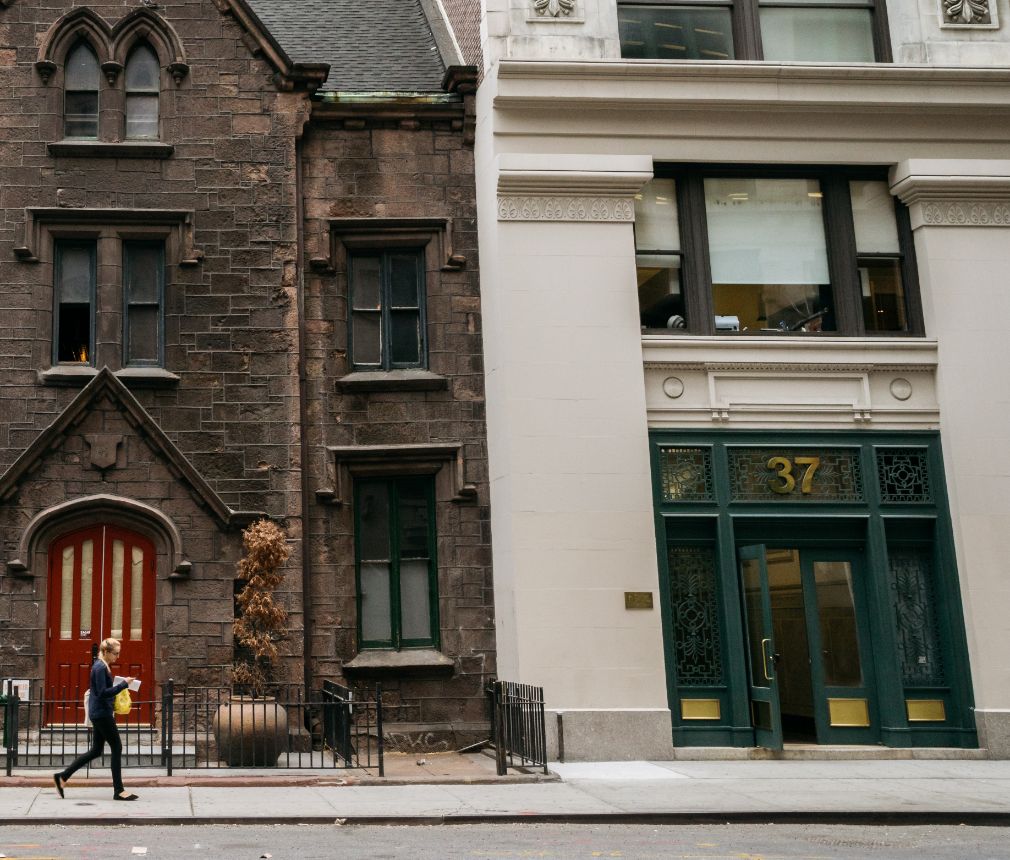Morton’s Neuroma Surgery
in New York City
Neuroma Surgery
When something isn’t right with your feet, you’ll feel it every step you take. Morton’s neuroma is a painful foot condition caused by inflammation of the nerves between the (metatarsal) bones behind the middle toes, leading to pain between your toes and the ball of your foot. This typically occurs in the third and fourth toes.
Morton’s neuroma is common and affects women 8 to 10 times more often than men.
Chelsea Foot and Ankle provides high-quality surgical and non-surgical treatment of Morton’s neuroma in New York City.
Neuroma

What Causes Morton’s Neuroma?
Morton’s neuroma is often associated with a response to injury, irritation, or pressure affecting the nerves that lead to your toes. It also can be the result of an inherited underlying structural alignment pattern that predisposes one to developing this painful condition.
Factors that strongly correlate to the development of Morton’s neuroma include:
- Tight, narrow, ill-fitting, and high-heeled shoes
- Repetitive trauma related to activities like jogging or running and sports that require tightly bound footwear, such as skiing or mountain climbing
- Other foot conditions like hammertoes, bunions, flatfeet, or high arches
Chelsea Foot and Ankle in New York City provides effective treatment for Morton’s neuroma to restore full foot function.
How Do I Know if I Have a Morton’s Neuroma?
An in-depth consultation with one of our top podiatrists is the first step to receiving a precise diagnosis and the relief you seek.
Our doctor(s) will thoroughly examine your feet and ankles to confirm the diagnosis and rule out other possible causes of your pain.
They will listen carefully to your symptoms and concerns and create a treatment plan that will include the appropriate diagnostic imaging and procedure(s) for your specific condition.
Some typical neuroma symptoms include:
- Sharp pain between toes
- Feet burn when standing or walking
- Noticeable inflammation between toes
- Numbness or tingling between toes
- A clicking sensation in the ball of the foot
- Pain on the balls of your feet
- A sensation of pebbles under your feet
- A feeling that your sock is wadded up under the base of the toes where they meet the foot
Why Choose
Chelsea Foot and Ankle
To Treat Your Neuroma?
To us, our patients and our team are family, and you can expect to be treated like the VIP you are.
We respect you and your time and are committed to improving your quality of life by offering comprehensive services at reasonable prices customized to meet your unique needs.
What Are Your Non-Surgical Treatment Options for Morton’s Neuroma?
While Dr. Ciment is a highly qualified and skilled foot surgeon, he almost always initially attempts to address your neuroma more conservatively with the following approaches:
- Alcohol injections
- Anti-inflammatory medications
- Corticosteroid injection
- Custom orthotics
- Replacing shoes that are narrow or tight
- Replacing jogging with other forms of exercise
- Regularly icing the feet
- Wearing pads inside shoes to cushion feet while walking
- Wearing wider, more comfortable shoes and avoiding high heels
Advanced therapies that may be used include:
- Cryoablation
- Extracorporeal shockwave therapy (ESWT)
Additionally, at Chelsea Foot & Ankle, we offer a minimally invasive treatment of neuromas called radiofrequency ablation (RFA). This treatment utilizes targeted heat to raise the temperature of the sensory nerve and alleviate pain associated with neuromas. In this RFA therapy blog, we go more in-depth on this specialized treatment and how it can be used to treat your Morton’s neuromas.
What if You Need Surgery for Morton’s Neuroma?
If surgery is indicated for the neuroma, you can rest assured that our foot surgeons perform this procedure regularly and have the skill and experience to correct your condition successfully.
One type of surgical treatment for your neuroma involves removing the nerves in the ball of the foot (neurectomy). A small incision is made on top of the foot through which your surgeon will remove the affected nerves and release any tight ligaments in the area.
Another type of surgical treatment for your neuroma spares the nerve. In this procedure (a decompression neuroplasty or a KOBY-Gard procedure), the tight soft tissues surrounding the affected nerves are carefully released via a tiny incision between the toes. Using a specially designed instrument that protects the nerves and blood vessels, the tight ligaments are released, and space is created so that the nerve is no longer pinched.
What Are the Benefits of Morton’s Neuroma Surgery in NYC?
At Chelsea Foot & Ankle, we use conservative methods whenever possible; surgery is never our first choice, as we understand that many patients want to avoid downtime and recovery as much as possible. Additionally, we want to exhaust all other treatments before surgery to minimize risk.
But, in some cases, surgery really is the best option for the treatment of Morton’s neuromas, and we are committed to providing the best possible care. The benefits of Morton’s neuroma surgery include:
- High success rates: when surgery becomes necessary, we often see a high rate of success and patient satisfaction
- Immediate reduction in discomfort and pain
- An improved quality of life: With reduced pain and discomfort, you can get back to living your life
What Is Recovery From Neuroma Surgery Like?
After surgery, you will be placed in a boot or cast to protect your foot and ankle. To make a full recovery, follow your doctor’s instructions, get plenty of rest, stay off your foot, ice, and elevate the foot as necessary. Most patients require a short course of physical therapy after the surgery.
Full recovery from this surgery can take a few weeks to a few months. Our surgeons at Chelsea Foot and Ankle take your recovery very seriously. They monitor our patients regularly with weekly follow-up visits and support you through the entire process until you’re back on your feet and feeling great.
How Can You Prevent Morton’s Neuroma?
Some tips to help you avoid Morton’s neuroma include:
- Avoid wearing tight, narrow, or high-heeled shoes.
- Ensure your shoes provide ample room for your toes so they don’t cramp.
- Wear well-cushioned athletic shoes that support the balls of your feet.
- Take steps to prevent any significant weight gain, as this puts added pressure on your feet.
- Athletes should discuss an alternate training routine with their coaches when experiencing symptoms caused by excess foot stress.
Morton’s Neuroma Surgery FAQ
Can Morton’s neuroma return after surgery?
While rare, it is possible to experience recurrent Morton’s neuroma. In some cases, this is due to a misdiagnosis, an insufficient surgical technique, or pressure being placed on the nerve stump of the neuroma.
One of the reasons we support extensive conservative treatments is to exhaust every avenue and administer as much diagnostic testing as necessary, to provide accurate diagnoses of Morton’s neuroma and avoid unnecessary surgery. At Chelsea Foot & Ankle, rest assured your care and diagnosis are as accurate as possible.
How painful is Morton’s neuroma surgery?
Morton’s neuroma surgery is usually performed using a local anesthetic, completely numbing the treatment area. Some physicians may recommend general anesthesia so that the patient is asleep. In any case, you will not feel any pain during your Morton’s neuroma surgery.
What can I expect after Morton’s neuroma surgery?
Morton’s neuroma surgery is one of the most effective treatments for Morton’s neuroma. After your recovery period, you can expect a vast improvement in pain, discomfort, and mobility.
How soon can I run after Morton’s neuroma surgery?
It is crucial to follow Dr. Ciment’s recommendations for postoperative Morton’s neuroma care. Aside from caring for your surgical site and getting plenty of rest after surgery, Dr. Ciment may recommend limited movement for quite some time. This is, in part, to help your surgical site heal, but it also helps minimize the risk of recurrent Morton’s neuroma. Getting back into exercise, especially running, may take some time–up to 3 months postop–but it’s important for your recovery and the success of your procedure.
Your New York City Podiatrist for Morton’s Neuroma Treatment
Whether you want to reduce symptoms and prevent a neuroma from getting worse with non-surgical treatment, or such methods have been unsuccessful and you require surgery, you can trust the professionals at Chelsea Foot and Ankle.
If you need relief from Morton’s neuroma, call our office today at (646) 929-4149! Don’t forget to check out our blog to learn more about us!
We always put our best foot forward…so you can too!

Our Patients Love Us
An absolutely amazing experience. Dr. Ciment is an absolutely wonderful person – it is very evident that he truly cares about his patients.
What a pleasure to meet Dr. Shastri. She was extremely personable, listened intently and actually was able to treat my condition to a fair extent in the first sitting.
Highly recommend her.
